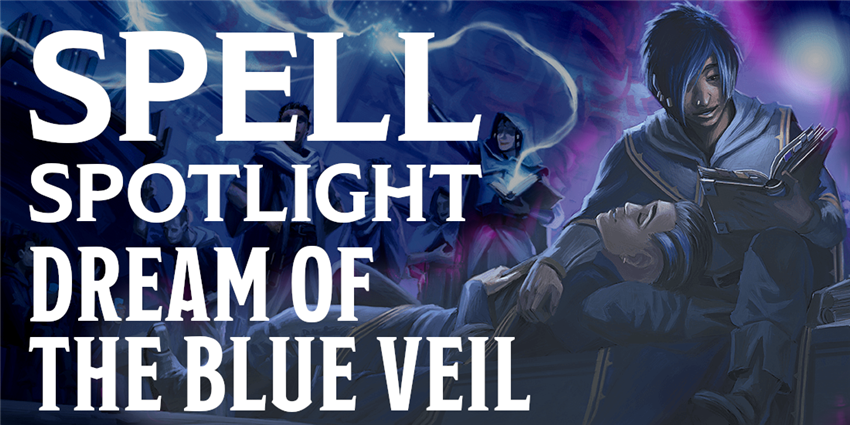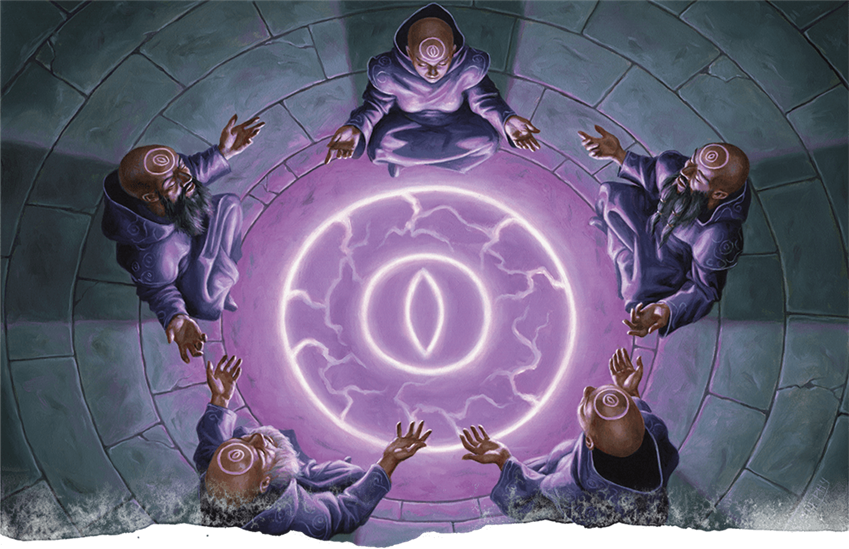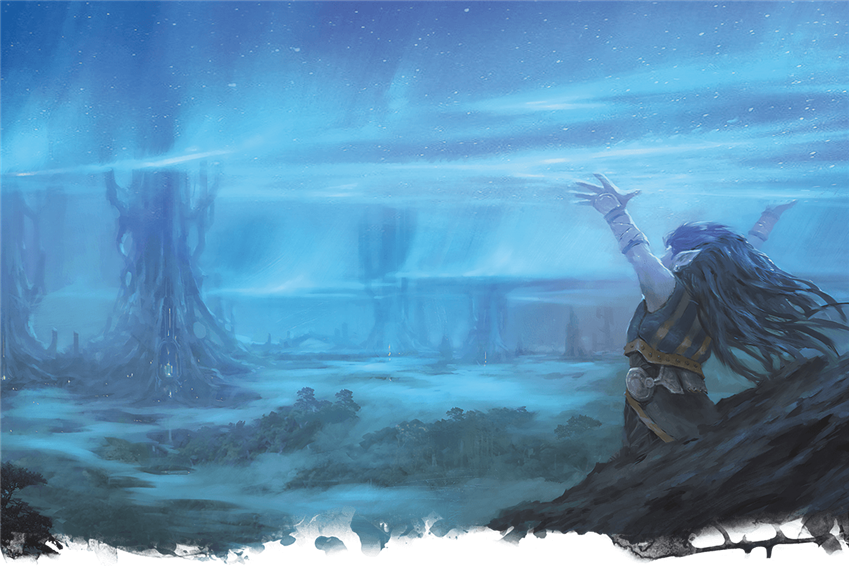Spell Spotlight examines D&D’s best, worst, and most interesting spells, giving you the tools you need to play a spellcaster who knows exactly what they’re doing. Today, we’re looking at a fascinating new spell from Tasha’s Cauldron of Everything that could transform your Dungeons & Dragons campaign: dream of the blue veil. Available to bards, sorcerers, warlocks, and wizards, this is an arcane spell that stands tall in the company of spells like teleport and plane shift. Its applications are straightforward—get from one place to another in the blink of an eye—but the where you wish to go could turn your Dungeon Master’s hair white (not blue) with shock!

For Players: Why Use Dream of the Blue Veil?
The Material Plane holds an infinite number of worlds. Some—like Oerth, Toril, Krynn, and Eberron—are well documented, but there are countless others. You and your friends may even have created some homemade D&D worlds yourselves!
Transit between these worlds is rare but not impossible and can be accomplished in various ways. One such method is […] the Dream of Other Worlds; travelers fall into a deep slumber and dream themselves into a new realm. The spell dream of the blue veil employs this method of transit. […] Whatever method you use to reach a world, the DM determines whether you succeed and where exactly you appear if you do arrive in that realm.
You know what they say: the world is not enough. One world isn’t, anyway. Teleport can take you from place to place on your world, and plane shift can take you to other realities, but the methods of travel between other worlds on the Material Plane aren’t so commonly known. There are several ways, at least one of which can only be accomplished by overcoming a grand and perilous journey—the stuff that epic adventures are made of! If you want your journey between worlds to be a little bit less harrowing, and you have the skill with arcane magic necessary to cast a 7th-level spell, dream of the blue veil is a much faster option, and it’s as easy as counting sheep.
So, why travel between worlds? What does Wildemount offer that Faerûn doesn’t, for example? There are plenty of reasons. You could just want a vacation, of course. I’ve heard that the Menagerie Coast is beautiful this time of year—and the Feolinn wineries are just starting to do their first tastings of the season. Dream of the blue veil is truly the private jet of the magically mighty.
But if you aren’t keen on spending 7th-level spell slots on frivolous endeavors, consider how useful it would be to escape to a realm where no one has ever heard your name. Depending on what world you go to, people may not have even met another person of your race before! A kalashtar wizard who uses the dream to flee the agents of the Dreaming Dark by escaping to Krynn may buy themself enough time to gather new allies, new resources, and return to Eberron with a bold new plan to defeat their enemies.
There may be plot reasons for the characters to seek a way to pierce the veil between worlds—an artifact or an oracle or some other MacGuffin resides on another world—but that’s such a DM-motivated endeavor that it hardly seems worth discussing here in the player-focused side of the article. A more interesting way of doing this sort of plot is to seed it at the very beginning. Perhaps your character is from another world, and on the morning of the first session of the campaign, they awoke in an unfamiliar inn, in an unfamiliar town, in an unfamiliar world. Some fifty sessions later, the party has grown to be heroes known throughout the land and the wizard has some mighty spells at their disposal—and they learn that some MacGuffin is on another world. Your homeworld. Now, your character has a personal connection to the unfolding saga of the dream of the blue veil, especially since…

The Dream’s Material Component: An Easily Overlooked Necessity
Buried at the bottom of the spell description (at least on D&D Beyond’s spell page), is a crucial material component. Do not overlook this. Using this spell requires you to have “a magic item or a willing creature” from the world you wish to travel to using the dream. Since acquiring such an item is entirely dependent upon your Dungeon Master providing the opportunity for such an item or creature to fall into the players’ clutches.
If you’re a player who saw this spell and got a mischievous little glint in your eye, and began dreaming of ways to juke the DM and derail your campaign by suddenly taking a vacation in Eberron from your problems in Faerûn, you’re fresh out of luck. These things work better for everyone when the DM is in on the joke, anyway! Let them know that you want to launch an otherworldly side-story and try to convince them into dropping the skull of a warforged that originated on Eberron into their next dungeon.
For Dungeon Masters: Planning a Multi-World Story
Once your players’ characters reach 13th level—the minimum level needed for a bard, sorcerer, warlock, or wizard to cast dream of the blue veil, a 7th-level spell—you’ll have hopefully played with that party enough to know what kind of adventures they like. It becomes tricky to run pre-published adventures at this high of a level, since your game will likely have become so idiosyncratic that any hardback adventure will need to be retooled significantly to suit your players’ preferences—to say nothing of your own!

So, break out your Dungeon Master’s Guide and start thinking about the power of other worlds. Check out other campaign settings, like Eberron: Rising from the Last War and Explorer’s Guide to Wildemount, and see what sets those worlds apart from others. Or better yet, check out the worldbuilding advice in chapter 1 of the Dungeon Master’s Guide and create your own new world for the party to explore. After all, published campaign settings aren’t the only worlds on the Material Plane. There are countless worlds. Some might be full, Earth-like fantasy settings that require you to do bookloads of worldbuilding, while others might be blasted rocks with only carefully woven spells from a long-dead civilization keeping their thin atmospheres from spiraling out into the great void beyond. A world like this could be planned in an afternoon, and provide enough adventure for a couple sessions’ worth of “dungeon” crawling.
So, why create a story that spans more than one world? One of the best reasons to do so is because you had an old campaign on another world, and now you want to involve retired characters or old NPCs in your current story. That’s a great way to get your old players’ interest!
Creating a worlds-spanning story can also crank up the epic scale of your story, and shift it from heroic fantasy into a more science-fantasy or “sword and planet” genre. This is the approach that D&D’s currently-dormant Spelljammer setting takes, as has the MMORPG World of Warcraft with expansions like The Burning Crusade and Legion. Beloved classic adventure games like The Legend of Zelda: A Link to the Past and Tales of Symphonia use parallel worlds to create a vast story that can draw interesting thematic parallels between one reality and another.
What will you do with the power to create worlds-spanning adventures? Are you a DM or a player—and what will you use this interesting new spell to do in your campaign?
Create A Brand-New Adventurer Acquire New Powers and Adventures Browse All Your D&D Content
 James Haeck is the lead writer for D&D Beyond, the co-author of Waterdeep: Dragon Heist, Baldur's Gate: Descent into Avernus, and the Critical Role Explorer's Guide to Wildemount, a member of the Guild Adepts, and a freelance writer for Wizards of the Coast, the D&D Adventurers League, and other RPG companies. He lives in Seattle, Washington with his fiancée Hannah and their animal companions Mei and Marzipan. You can find him wasting time on Twitter at @jamesjhaeck.
James Haeck is the lead writer for D&D Beyond, the co-author of Waterdeep: Dragon Heist, Baldur's Gate: Descent into Avernus, and the Critical Role Explorer's Guide to Wildemount, a member of the Guild Adepts, and a freelance writer for Wizards of the Coast, the D&D Adventurers League, and other RPG companies. He lives in Seattle, Washington with his fiancée Hannah and their animal companions Mei and Marzipan. You can find him wasting time on Twitter at @jamesjhaeck.











-
View User Profile
-
Send Message
Posted Dec 12, 2020This spell would have made more sense if WotC had released it as part of a Spelljammer expansion to the D&D 5th edition universe. The thing is IF the DM wanted the PCs to journey to other worlds, the DM would just insert some plot-related artifact or situation to make that happen. In which case, using this spell would mostly be either pointless or as a quick Escape button for the party if they got in trouble in a particular world, though only if the DM has already created or planned other worlds to exist simultaneously with whatever core universe the PCs had been adventuring in.
-
View User Profile
-
Send Message
Posted Dec 12, 2020Well, WotC has confirmed that they're releasing 5th Edition version of older settings next year. It's plausible that Spelljammer or Planescape will be one of them, which would give the spell some mileage.
-
View User Profile
-
Send Message
Posted Dec 13, 2020So if there's infinite material planes within the dnd cosmology, is there still only one feywild, one mount celestia? Why don't the gods of Exandria have any power in Theros?
-
View User Profile
-
Send Message
Posted Dec 13, 2020The Outer Planes (like Mount Celestia, Mechanus, Limbo, or Baator) are unique and touch nearly all Prime Material worlds- the Mount Celestia you can get to from Faerun is the same as the one from Greyhawk). The Feywild, Shadowfell, and Astral Plane are the same as well. As far as the gods go, while some have power that extends across multiple planes (Gruumsh or Lolth, for example), most are limited to a single world in the same way that the head of state of a particular country lacks authority in another country.
-
View User Profile
-
Send Message
Posted Dec 13, 2020My problem with this spell is that it kind-of nullifies the need for Spell-jamming ships at all. If one could use a 7th level spell to travel beyond the Crystal Spheres, it seems like a terrible amount of effort to construct a spell jamming ship that's purpose is to travel through space and survive the flogiston between Crystal Spheres. In my own game, I've removed Dream of the Blue Veil from all spell lists, and instead placed it upon a scroll that has been made by an incredibly powerful wizard. I don't think this spell should be so readily accessible, but I do believe if players get their hands on it, they should have the right to use it.
This also allows me to introduce the spell when there's some context to actually needing the spell, rather than the spell sitting on player's spell lists, tempting them to pick it even if they don't necessarily have a reason to take it, just because its a cool spell.
-
View User Profile
-
Send Message
Posted Dec 13, 2020They could be releasing Dark Sun, and introducing psionic classes that way.
...maybe
...hopefully
-
View User Profile
-
Send Message
Posted Dec 13, 2020Again, this is completely up to the DM. It just depends whether or not they want you to use this spell, or take the time to construct a spelljammer and focus on the journey between the planes. The material component is what I think a lot of people are missing, and it's actually easier to make a spelljamming ship than it is to use this spell if the DM has no plans on planeshifting.
-
View User Profile
-
Send Message
Posted Dec 13, 2020Quite honestly the last bit I like but also see no reason establishing XD
-
View User Profile
-
Send Message
Posted Dec 14, 2020Only if you never want to transport more than yourself and eight other characters. And you've got the needed material component for your destination. If you need to get a large group there, or a large amount of cargo? Spelljamming is the way to go.
-
View User Profile
-
Send Message
Posted Dec 14, 2020I wouldn't mind taking this spell if it just allowed my party to do just that. Dark Sun is such a flavorful and original take on fantasy world-building. Miles more intriguing than the old canned Tolkien-esque-medieval times-whatnot rehash.
-
View User Profile
-
Send Message
Posted Dec 14, 2020Ultimate DM destruction tactic: Charm the BBEG and take them to Athas, or any other hellplane your universe has, and strand them there.
-
View User Profile
-
Send Message
Posted Dec 15, 2020I love that.
-
View User Profile
-
Send Message
Posted Dec 22, 2020The existence of this spell implies that travel to other worlds is possible and that they are on the Material Plane. So, Teleport and Plane shift (from other plane or demiplane) should work to move to the other worlds. Also it's possible to reproduce Dream of the blue veil with Wish, and in this case material components are not needed.
-
View User Profile
-
Send Message
Posted Dec 23, 2020Sure, except DMs are notorious for screwing up Wishes.
-
View User Profile
-
Send Message
Posted Dec 23, 2020Yes, but the description of Wish states that using it to duplicate a lower level spell always works as intended. If the GM still screws you over, they're not playing fair to begin with.
-
View User Profile
-
Send Message
Posted Dec 24, 2020As a DM who has felt too pressured to come up with a good story and just screwed the wish over multiple times, it is hard to keep the caster balanced while still providing a good story. The best way to do it is to not say it fails, but to use an inherent flaw in the wording to create a different story, as opposed to just saying no or completing the story at the very beginning or in the middle. For example, the wish could be "I wish for [main boss] to be dead", causing a much more powerful creature to come out of the shadows, kill the main boss in one swipe, then turn on the characters(yes, this was inspired by a climax idea in the DMG).
-
View User Profile
-
Send Message
Posted Dec 24, 2020Again, what happens if you wish for this spell is far from clear. Where was a nonexistent item created, or a nonexistent creature born? Is it even possible to travel to such a location?
-
View User Profile
-
Send Message
Posted Dec 29, 2020It would be up to you, but in my opinion, YES LET'S GO TO THE HIGH-CONCEPT PLANE OF NONEXISTENCE. That would be a super weird adventure but it might be a fun one.
-
View User Profile
-
Send Message
Posted Feb 9, 2021Does this mean that the Spelljammer setting is returning?
-
View User Profile
-
Send Message
Posted Feb 10, 2021Possibly. I think WotC announced that they were bringing classic settings yp 5e but they didn’t say which.